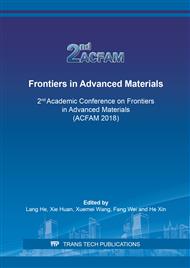[1]
F. Hu, J. Wang, S. Hu, L. Li, G. Wang, J. Qiu, X. Jian, Inherent N, O-containing carbon frameworks as electrode materials for high-performance supercapacitors, Nanoscale. 8 (2016) 16323-16331.
DOI: 10.1039/c6nr05146d
Google Scholar
[2]
S. Das, P. Heasman, T. Ben, S. Qiu, Porous organic materials: strategic design and structure–function correlation, Chem. Rev. 117 (2016) 1515-1563.
DOI: 10.1021/acs.chemrev.6b00439
Google Scholar
[3]
F. Hu, J. Wang, S. Hu, L. Li, W. Shao, J. Qiu, Z. Lei, W. Deng, X. Jian, Engineered fabrication of hierarchical frameworks with tuned pore structure and N,O-co-doping for high-performance supercapacitors, ACS Appl. Mater. Interfaces. 9 (2017) 31940-31949.
DOI: 10.1021/acsami.7b09801
Google Scholar
[4]
S.S. Han, W.A. Goddard, Lithium-doped metal-organic frameworks for reversible H2 storage at ambient temperature, J. Am. Chem. Soc. 129 (2007) 8422-8423.
DOI: 10.1021/ja072599+
Google Scholar
[5]
J.R. Hunt, C.J. Doonan, J.D. LeVangie, A.P. Cote, O.M. Yaghi, Reticular synthesis of covalent organic borosilicate frameworks, J. Am. Chem. Soc. 130 (2008) 11872-11873.
DOI: 10.1021/ja805064f
Google Scholar
[6]
C. Gu, D. Liu, W. Huang, J. Liu, R. Yang, Synthesis of covalent triazine-based frameworks with high CO 2 adsorption and selectivity, Polym. Chem. 6 (2015) 7410-7417.
DOI: 10.1039/c5py01090j
Google Scholar
[7]
P. Katekomol, J. Roeser, M. Bojdys, J. Weber, A. Thomas, Covalent triazine frameworks prepared from 1,3,5-Tricyanobenzene, Chem. Mater. 25 (2013) 1542-1548.
DOI: 10.1021/cm303751n
Google Scholar
[8]
P. Kuhn, M. Antonietti, A. Thomas, Porous covalent triazine-based frameworks prepared by ionothermal synthesis, Angew. Chem. Int. Ed. 47 (2008) 3450-3453.
DOI: 10.1002/anie.200705710
Google Scholar
[9]
P. Kuhn, A. Forget, D. Su, A. Thomas, M. Antonietti, From microporous regular frameworks to mesoporous materials with ultrahigh surface area: dynamic reorganization of porous polymer networks, J. Am. Chem. Soc. 130 (2008) 13333-13337.
DOI: 10.1021/ja803708s
Google Scholar
[10]
D.Y. Osadchii, A.I. Olivos-Suarez, A.V. Bavykina, J. Gascon, Revisiting nitrogen species in covalent triazine frameworks, Langmuir. 33 (2017) 14278-14285.
DOI: 10.1021/acs.langmuir.7b02929
Google Scholar
[11]
L.J. Abbott, K.E. Hart, C.M. Colina, Polymatic: a generalized simulated polymerization algorithm for amorphous polymers, Theor. Chem. Acc. 132 (2013) 1321-1334.
DOI: 10.1007/s00214-013-1334-z
Google Scholar
[12]
L.J. Abbott, C.M. Colina, Atomistic structure generation and gas adsorption simulations of microporous polymer networks, Macromolecules. 44 (2011) 4511-4519.
DOI: 10.1021/ma200303p
Google Scholar
[13]
S.J. Rukmani, T.P. Liyana-Arachchi, K.E. Hart, C.M. Colina, Ionic-functionalized polymers of intrinsic microporosity for gas separation Aapplications, Langmuir. 34 (2018) 3949-3960.
DOI: 10.1021/acs.langmuir.7b04320
Google Scholar
[14]
P. Fayon, A. Trewin, Formation mechanism of ultra porous framework materials, Phys. Chem. Chem. Phys. 18 (2016) 16840-16847.
DOI: 10.1039/c6cp02764d
Google Scholar
[15]
P. Fayon, J.M.H. Thomas, A. Trewin, Structure and properties of a nanoporous supercapacitor, J. Phys. Chem. C. 120 (2016) 25880-25891.
DOI: 10.1021/acs.jpcc.6b08712
Google Scholar
[16]
C. Reece, D.J. Willock, A. Trewin, Modelling analysis of the structure and porosity of covalent triazine-based frameworks, Phys. Chem. Chem. Phys. 17 (2015) 817-823.
DOI: 10.1039/c4cp04046e
Google Scholar
[17]
S. Jiang, K.E. Jelfs, D. Holden, T. Hasell, S.Y. Chong, M. Haranczyk, A.Trewin, A.I. Cooper, Molecular dynamics simulations of gas selectivity in amorphous porous molecular solids, J. Am. Chem. Soc. 135 (2013) 17818-17830.
DOI: 10.1021/ja407374k
Google Scholar
[18]
T. Düren, F. Millange, G. Férey, K.S. Walton, R.Q. Snurr. Calculating geometric surface areas as a characterization tool for metal-organic frameworks, J. Phys. Chem. C. 111 (2007) 15350-15356.
DOI: 10.1021/jp074723h
Google Scholar
[19]
L.D. Gelb, K.E. Gubbins, Characterization of porous glasses: Simulation models, adsorption isotherms, and the Brunauer-Emmett-Teller analysis method, Langmuir. 14 (1998) 2097-2111.
DOI: 10.1021/la9710379
Google Scholar
[20]
M. Pinheiro, R.L. Martin, C.H. Rycroft, A. Jonesc, E. Iglesia, M. Haranczyk, Characterization and comparison of pore landscapes in crystalline porous materials, J. Mol. Graph. 44 (2013) 208-219.
DOI: 10.1016/j.jmgm.2013.05.007
Google Scholar


